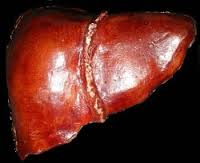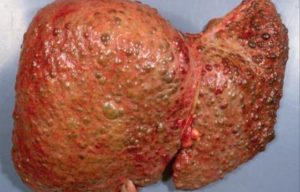HEALTHY LIVER LIVER DISEASED
The liver is an organ about the size of a football that sits just under your rib cage on the right side of your abdomen. The liver is essential for digesting food and ridding your body of toxic substances.
Liver disease can be inherited (genetic) or caused by a variety of factors that damage the liver, such as viruses and alcohol use. Obesity is also associated with liver damage.
Over time, damage to the liver results in scarring (cirrhosis), which can lead to liver failure, a life-threatening condition.
What is cirrhosis of the liver?
Cirrhosis is a complication of many liver diseases characterized by abnormal structure and function of the liver. The diseases that lead to cirrhosis do so because they injure and kill liver cells, after which the inflammation and repair that is associated with the dying liver cells causes scar tissue to form. The liver cells that do not die multiply in an attempt to replace the cells that have died. This results in clusters of newly-formed liver cells (regenerative nodules) within the scar tissue.
What are the causes of cirrhosis?
There are many causes of cirrhosis including chemicals (such as alcohol, fat, and certain medications), viruses, toxic metals (such as iron and copper that accumulate in the liver as a result of genetic diseases), and autoimmune liver disease in which the body’s immune system attacks the liver.
Why does cirrhosis cause problems?
The liver is an important organ in the body. It performs many critical functions, two of which are producing substances required by the body, for example, clotting proteins that are necessary in order for blood to clot, and removing toxic substances that can be harmful to the body, for example, drugs. The liver also has an important role in regulating the supply of glucose (sugar) and lipids (fat) that the body uses as fuel. In order to perform these critical functions, the liver cells must be working normally, and they must have a close proximity to the blood because the substances that are added or removed by the liver are transported to and from the liver by the blood.
The relationship of the liver to the blood is unique. Unlike most organs in the body, only a small amount of blood is supplied to the liver by arteries. Most of the liver’s supply of blood comes from the intestinal veins as the blood returns to the heart. The main vein that returns blood from the intestines is called the portal vein. As the portal vein passes through the liver, it breaks up into increasingly smaller and smaller veins. The tiniest veins (called sinusoids because of their unique structure) are in close contact with the liver cells. In fact, the liver cells line up along the length of the sinusoids. This close relationship between the liver cells and blood from the portal vein allows the liver cells to remove and add substances to the blood. Once the blood has passed through the sinusoids, it is collected in increasingly larger and larger veins that ultimately form a single vein, the hepatic vein, which returns the blood to the heart.
In cirrhosis, the relationship between blood and liver cells is destroyed. Even though the liver cells that survive or are newly-formed may be able to produce and remove substances from the blood, they do not have the normal, intimate relationship with the blood, and this interferes with the liver cells’ ability to add or remove substances from the blood. In addition, the scarring within the cirrhotic liver obstructs the flow of blood through the liver and to the liver cells. As a result of the obstruction to the flow of blood through the liver, blood “backs-up” in the portal vein, and the pressure in the portal vein increases, a condition called portal hypertension. Because of the obstruction to flow and high pressures in the portal vein, blood in the portal vein seeks other veins in which to return to the heart, veins with lower pressures that bypass the liver. Unfortunately, the liver is unable to add or remove substances from blood that bypasses it. It is a combination of reduced numbers of liver cells, loss of the normal contact between blood passing through the liver and the liver cells, and blood bypassing the liver that leads to many of the manifestations of cirrhosis.
A second reason for the problems caused by cirrhosis is the disturbed relationship between the liver cells and the channels through which bile flows. Bile is a fluid produced by liver cells that has two important functions: to aid in digestion and to remove and eliminate toxic substances from the body. The bile that is produced by liver cells is secreted into very tiny channels that run between the liver cells that line the sinusoids, called canaliculi. The canaliculi empty into small ducts which then join together to form larger and larger ducts. Ultimately, all of the ducts combine into one duct that enters the small intestine. In this way, bile gets to the intestine where it can help with the digestion of food. At the same time, toxic substances contained in the bile enter the intestine and then are eliminated in the stool. In cirrhosis, the canaliculi are abnormal and the relationship between liver cells and canaliculi is destroyed, just like the relationship between the liver cells and blood in the sinusoids. As a result, the liver is not able to eliminate toxic substances normally, and they can accumulate in the body. To a minor extent, digestion in the intestine also is reduced.

